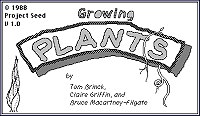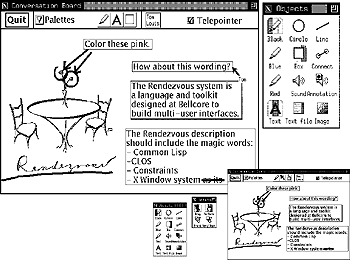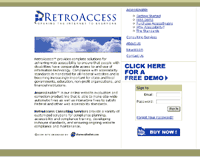From the start, a few core interests of mine converged in the field of usability, and web design in particular: technology, creativity, the humane use of technology, and a persistent frustration with poor design.
Apple Computer
 I've been officially working in the field of usability (or, more formally, human-computer interaction) since around 1986, when I began summer jobs and internships in education research at Apple Computer. I worked for 2 years on Project Seed, which explored the use of computer simulations in elementary science education, then moved for another year onto a project in adult technical training that combined multimedia and expert-systems based simulation.
I've been officially working in the field of usability (or, more formally, human-computer interaction) since around 1986, when I began summer jobs and internships in education research at Apple Computer. I worked for 2 years on Project Seed, which explored the use of computer simulations in elementary science education, then moved for another year onto a project in adult technical training that combined multimedia and expert-systems based simulation.
Stanford University
In the midst of working for Apple, I got my masters degree in computer science at Stanford. At the time, my main interest was in developing easier-to-use programming environments, and I followed a custom-designed program focusing on programming languages and user interface design, with substantial work in cognitive psychology. My personal goal from then onward was to develop strong skills in all the primary fields that contribute to human-computer interaction.
Toshiba
Immediately after Stanford, I worked for a summer in Toshiba's Man-Machine Interface group. This was an amazing opportunity to experience Japan, both in the workplace and outside. There I worked on the user interface for a speech synthesis research system.
Bellcore
Returning from Japan, I went to Bellcore for 3 years. Bellcore was a telecommunications research organization owned by the Baby Bells. During my time there I regularly took graphic design night courses in New York City. My department at Bellcore focused on internet services research, and I was involved in research on user interface toolkits, groupware, and videoconferencing.

Bellcore at that time was a nexus of leading-edge research. My heaviest influences were from my 2 closest co-workers, Ralph Hill and Steve Rohall, who were extraordinarily bright and supportive. Also, John Patterson was an informal mentor who provided wise advice to me as a young strapling. My department had several other industry thought-leaders (actually, too many to mention), such as Nathaniel Borenstein (internet guru and entrepreneur, now affiliated with U. of Michigan), Louis Gomez (now doing education research at Northwestern), and Bob Kraut (now in HCI at Carnegie-Mellon). Outside my department were several other influential thinkers who I frequently got to interact with, such as George Furnas (now in HCI at U. of Michigan), Jakob Nielsen, and Tom Landauer. It was an unbeatable opportunity to be in an organization with so many brilliant people who would come to play such prominent roles in human-computer interaction and the internet.
University of Michigan
While I had excellent experiences at Bellcore, my career was staying too strongly tied to software development, and I chose to return to the University of Michigan to study cognitive psychology. I worked there with Gary and Judy Olson, who have been extraordinarily influential on my future work. I got a masters degree in psych and began my doctorate work. My research focused on how people communicate with drawings, but I got prematurely pulled away from school by the advent of the Web.
Diamond Bullet Design
In 1995, I had been experimenting with the Web for a couple years when suddenly I had an inspiration. Web design combined all of my key interests: design, technology, usability. It was the perfect career I'd been preparing for my whole life, and so I sought out people to help me form a business. Diamond Bullet was officially founded in January 1996 with the key focus of applying usability principles to the Web.
We focused from the beginning on adapting all of the traditional usability methods to web design, and we were extremely successful in doing so. We also provided usability services to traditional software development organizations. Some particularly good experiences for me were: a 6 month consulting project where I served as the user interface designer of a computer-based patient record system, work with the Michigan Ross School of Business, and the design of pdtrials.org, a site for Parkinson's disease patients.
When my business partner, Stephen Markel, passed away in 2004, Diamond Bullet lost an essential team member. In early 2005 we sold the assets of our web banking business to our partner Certegy, and in mid-2005 we sold the remaining assets to Foraker Design.
RetroAccess
 In a particularly interesting information architecture project for a government website, we became involved in extensive work in optimizing the accessibility of the site. Accessibility has always been a crucial part of usability, and this experience led to the development of a nice technology for evaluating and improving the accessibility of websites. Diamond Bullet then created RetroAccess as a spin-off company with our product AccessEnable.
While the core ideas of RetroAccess were compelling, the field was highly competitive,
and RetroAccess was re-absorbed into Diamond Bullet in 2004.
In a particularly interesting information architecture project for a government website, we became involved in extensive work in optimizing the accessibility of the site. Accessibility has always been a crucial part of usability, and this experience led to the development of a nice technology for evaluating and improving the accessibility of websites. Diamond Bullet then created RetroAccess as a spin-off company with our product AccessEnable.
While the core ideas of RetroAccess were compelling, the field was highly competitive,
and RetroAccess was re-absorbed into Diamond Bullet in 2004.
Usability for the Web
In 2001, I wrote the book "Usability for the Web: Designing Web Sites that Work" with Darren Gergle and Scott D. Wood, who both were heavily involved in defining the direction and developing the usability processes at Diamond Bullet.
University of Michigan School of Information
Since 2000, I've taught User Interface Design at the University of Michigan as an adjunct instructor. This has been a delightful experience working with highly-motivated and
creative graduate students over the last several years.
My course emphasizes the process of design from a practical perspective.
So What's It All About?
My career has focused on creatively applying usability in a variety of domains. I've emphasized the need for a multi-disciplinary approach and a practical, process-based approach. I work to make a difference. Real systems for real people need radical simplification, innovation, and high quality.